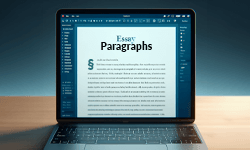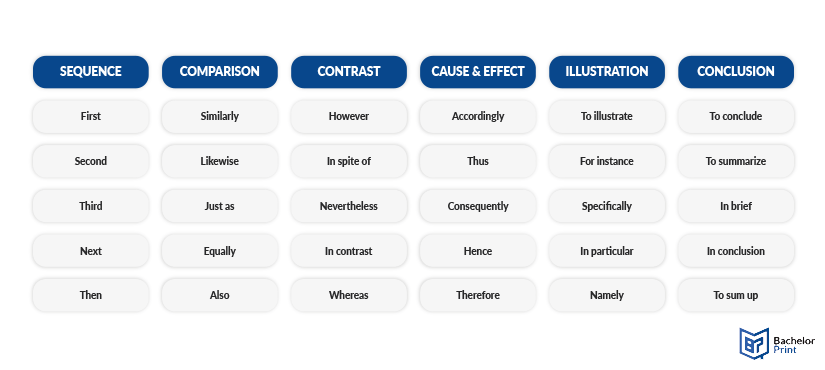
Being able to craft coherent sentences is essential for sustaining a convincing argument. Each section serves as a building block, contributing to the clarity of the entire idea. By bringing ideas and evidence into a natural flow, your work will be much more readable. This article explores the key elements of paragraphs in academic writing, and offers practical tips for enhancing their impact and readability.
Definition: Paragraphs
Paragraphs serve as the basic structural component of written discourse, facilitating the organization and flow of ideas within a larger piece of writing. Typically, a coherent paragraph begins with a topic sentence that functions as a bridge between the current paragraph and the preceding one. It serves as a roadmap for readers, informing them of what to expect in this section and providing a clear focus for the consecutive sentences.
The controlling idea is embedded within the topic sentence, and is then followed by supporting details or evidence that further develop the unified idea. Together, they ensure that each section remains focused and coherent, with all sentences working together to convey a unified message or argument. Both are essential for effective communication in various forms of written discourse, including essays, reports, and articles.
In academic essays, paragraphs are typically between 100 and 200 words long, which should usually be a maximum of 10 sentences. For creative writing, they may vary in length to create pacing and mood. Every piece of writing longer than a couple of sentences should be divided into blocks. This ensures a flow that is logical and comprehensible for the reader. Thus, paragraphs play a crucial role in organizing and presenting ideas effectively in written communication by enhancing readability and contributing to the overall coherence of a text.
Types of paragraphs
Paragraphs can be divided into four different types: descriptive, narrative, expository, and persuasive. Each of these types allows you to write about any topic you desire. Understanding each of them can enhance a writer’s ability to effectively communicate ideas across various genres and styles of writing.
Descriptive paragraphs aim to create a vivid mental picture or sensory experience for the reader. They use detailed language to paint a clear image of a thing or person, which can be achieved through the use of the five senses: touch, smell, sight, sound, and taste.
Narrative paragraphs tell a story or recount a series of events in a chronological order. This particular type of paragraph has a clear beginning, middle, and end.
Expository paragraphs explain, analyse, or inform readers on a particular topic, aiming to clarify concepts or present arguments in a clear and straightforward manner.
Persuasive sections, as the name entails, aim to persuade the reader to adopt a specific viewpoint or take a particular action. They present evidence and reasoning to support a central claim or position.
Structure of paragraphs
There exists a consensus regarding the format of a single paragraph, no matter the type or genre. This basic structure provides a framework for organizing ideas within a section, and ensures clarity.
- Introduction: The first section should include the controlling idea or main point that will be discussed. The clear-cut topic sentence provides the reader with a basic grasp on what the section will focus on.
- Body: The supporting sentences follow the previous sentence and provide further elaboration, explanation, evidence, examples, or details related to the main idea.
- Conclusion: The concluding sentence wraps up the section by summarizing the main point in relation to the broader context of the writing. It provides closure and also serves as a transition to the next part.
Paragraph examples
In this section, you’ll find detailed explanations and examples for each of the essay types.
Descriptive writing
A descriptive essay focuses on describing a subject or an event in vivid detail, appealing to the reader’s senses. Understanding its building blocks is essential, which is why you should consider making a list of ideas for the subject based on each of the five senses.
Let’s say the topic is “Camping in the woods for the first time.” Illustrated below, is an example list and an entire paragraph for this descriptive essay.
Narrative writing
A narrative essay tells a story, typically from the author’s first-person perspective, using a chronological sequence of events to engage the reader. It often includes characters, settings, conflicts, and resolutions. They are a great way to grow your vocabulary. When writing this type of essay, it is recommended to have adequate research or experience with the topic.
Below, you’ll find an example paragraph for the narrative essay topic “Arriving in Germany as a foreigner.”
Expository writing
Expository essays aim to inform or analyse a topic in a clear and concise manner. They present factual information and explore concepts, often using evidence and examples to support their point. Unlike the essays prior, this type lacks the requirements for creative freedom, solely focusing on facts and objectiveness. For this essay, there are different types of paragraphs available.
- Informative paragraphs might explain a process, describe a category, or provide a long definition of something complicated. They are useful for educational and business writing.
- A compare-contrast paragraph is used to examine similarities and differences. This type of section is beneficial for literature reports and reviews.
- Cause and effect paragraphs indicate why the cause of a problem results in its consequences (the effect.) The purpose of this is to help the reader understand the cause of a situation.
Persuasive writing
Persuasive essays seek to persuade the reader to consider a particular viewpoint, written in the third person. They use logic, reasoning, evidence, and formal language to convince the audience of the validity of the author’s position. There are three core rhetorical tools that make a great persuasive essay: ethos, pathos, and logos, meaning appeal to authority, emotions, and logic.
A very helpful method to structure each paragraph in your persuasive writing, is the TEEL strategy, which includes a Topic sentence, an Explanation, an Example/Evidence, and a Linking sentence. The example essay topic is: The importance of recycling in reducing environmental pollution.
Transition words
Transition words and phrases serve as a means of linking sections and concepts, thereby establishing logical connections between paragraphs and sections of your papers. They instruct the reader how to piece your ideas together to form a convincingly coherent argument. Below, you’ll find an illustration with transition word examples you can use in specific contexts.

Establishing coherence
A well-organized paragraph is crucial for ensuring that your writing is clear. Every sentence should have a direct link to the single controlling idea, exhibiting a seamless flow of sentences, devoid of abrupt alternations or discontinuities. More importantly, it emphasizes the connections between previously presented information and newly introduced concepts, thereby illuminating the structure of ideas or arguments for the reader.
By implementing the strategies below, you can enhance the coherence of your paragraphs and improve the overall quality of your writing.
- Use transitional words: As mentioned prior, transitional words or phrases help to connect ideas from sentence to sentences. They provide cues to the reader about the relationship between different pieces of information, making your writing flow smoothly.
- Be Consistent: Stick to a consistent point of view throughout your piece of writing. Switching between perspectives, verb tenses, and numbers can potentially confuse or irritate the reader and disrupt the flow of your writing immensely.
- Use parallel structure: Use parallel structure to express similar connections between ideas consistently. This involves using the same grammatical structure for items in a list, which enhances readability, and helps the reader see the connections from idea to idea.
- Avoid repetition: While some repetition is necessary for emphasis, too much can detract from coherence. Use synonyms or rephrase sentences to avoid using the same words or phrases too frequently within a paragraph.
Dos and don’ts
Constructing good paragraphs is essential for effective communication and comprehension when writing an essay. To summarize this article, you will find a list of dos and don’ts given below, which you should adhere to while constructing sections.
Dos
Brainstorm fantastic ideas & an outline
Relevant topic sentence
Useful evidence/examples
Use transitional words
Focus on the main idea in each section
Vary sentence structure
Conclude with a summary or transition
Don’ts
Don’t forget the topic sentence
Don’t include irrelevant info
Don’t expect readers to know jargon
Don’t make unsupported claims
Don’t put multiple ideas in one section
Don’t neglect coherence and clarity
Don’t forget to revise and edit
numerous advantages for Canadian students:
- ✓ 3D live preview of your configuration
- ✓ Free express delivery for every order
- ✓ High-quality bindings with individual embossing

FAQs
- Determine the main idea.
- Start with a topic sentence introducing the main idea.
- Provide supporting details.
- Use transitional words for coherence.
- Maintain focus on the main idea.
- Conclude with a summary or closing thought.
- Revise and edit your paragraph.
In English academic writing, there is no strict rule for the number of sentences in a paragraph. It can consist of at least three sentences, though rarely more than ten.
A topic sentence is a sentence that introduces the main idea of a paragraph. It serves as a guidepost for the reader, indicating what the section will be about. It should be clear and directly related to the overall thesis statement or main argument of the writing.
New idea: To begin with, firstly, one key aspect is, another important consideration is…
Examples/Evidence: For instance, to illustrate, specifically, in particular…
Contrast: On the other hand, however, conversely, nevertheless…
Summary: Therefore, as a result, in conclusion, to summarize…
The four types are descriptive, narrative, expository, and persuasive paragraphs.
